 |
QUICK SEARCH
MO PROJECTS:
Africa
Asia/Pacific
Mesoamerica
North America
South America
General Taxonomy
Photo Essays
Training in Latin
America
MO RESEARCH:
Wm. L. Brown Center
Bryology
GIS
Graduate Studies
Research Experiences
for Undergraduates
Imaging Lab
Library
MBG Press
Publications
Climate Change
Catalog Fossil Plants
MO DATABASES:
W³MOST
Image Index
Rare Books
Angiosperm
Phylogeny
Res Botanica
All Databases
INFORMATION:
What's New?
People at MO
Visitor's Guide
Herbarium
Jobs & Fellowships
Symposium
Research Links
Site Map
Search
|
Introduction: The “Lost World” of the
|
|||||||||||||||||||||||||||||||||||||||||||||||||||||||||||||||||||||||||||||||||||||||||||||||||||||||||||||||||||||||||||||||||||||||||||||||||||||||||||||||||||||||||||||||||||||||||||||||||||||||||||||||||||||||||||||||||||||||||||||||||||||||||||||||||||||||||||||||||||||||||||||||||||||||||||||||||||||||||||||||||||||||||||||||||||||||||||||||||||||||||||||||||||||||||||||||||||||||||||||||||||||||||||||||||||||||||||||||||||||||||||||||||||||||||||||||||||||||||||||||||||||||||||||||||||||||||||||||||||||||||||||||||||||||||||||||||||||||||||||||||||||||||||||||||||||||||||||||||||||||||||||||||||||||||||||||||||||||||||||||||||||||||||||||||||||||||||||||||||||||||||||||||||||||||||||||||||||||||||||||||||||||||||||||||||||||||||||||||||||||||||||||||||||||||||||||||||||||||||||||||||||||||||||||||||||||||||||||||||||||||||||||||||||||||||||||||||
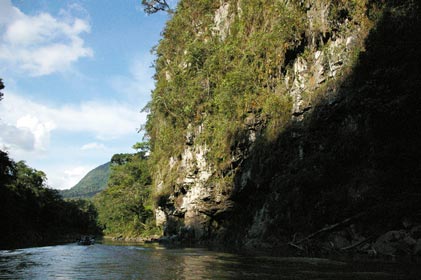 |
The region of isolated sandstone table mountains of the Guayana Highlands in southern Venezuela and adjacent countries – the biogeographical “Pantepui” is sometimes known popularly as the “Lost World”, because it was the remote and mysterious setting of Arthur Conan Doyle’s novel (1912) of that name, in which scientists discovered dinosaurs and other prehistoric animals roaming the heights of the tepuis. Floristically, the Pantepui region is known among botanists as somewhat of a world apart due to the large number of endemic taxa that have evolved there over long periods of time on the ancient erosion surfaces of the sandstone tepuis. In the Guayana highlands 23 endemic genera and over 1,000 endemic species have been recorded, and 138 endemic genera in the larger region of the Guayana Shield as a whole (Berry et al. 1995; Berry & Riina 2005, Rull 2007).
Prior to the present floristic inventory project, it was also known that there are a number of genera that are “almost endemic” to the Guayana Shield except for one or more outliers in other regions (Berry et al. 1995). Most, or perhaps all of these outlier taxa are restricted to nutrient-poor sandstone or lowland white sand areas outside of the Guayana Shield. When we initiated the project, five of these “sandstone outlier” genera had been reported from the Cordillera del Cóndor region: Bonnetia (Bonnetiaceae), Everardia (Cyperaceae), Phainantha (Melastomataceae) Pterzonium (Pteridaceae) and Stenopadus (Asteraceae). During the course of the fieldwork in the Cordillera del Cóndor, we have recorded several other genera, not previously known from the region that are additional “Guayana Shield outliers”; these include Digomphia (Bignoniaceae) and Retiniphyllum (Rubiaceae). Some taxa in the Cordillera del Cóndor are apparently species-level disjuncts from the tepuis of the Guayana highlands, including Retiniphyllum tepuiense and Podocarpus tepuiensis; these are not recorded from anywhere outside of the Pantepui region except for the populations on the sandstone summits of the Cordillera del Cóndor, more than 2,000 km distant from Pantepui.
We also have registered a number of other genera that were previously not known from Ecuador; most of these latter occur on the scattered patches of white sand in lowland Amazonia. Among these genera recently discovered in the Cordillera del Cóndor that are new to Ecuador are Krukoviella (Ochnaceae), Hortia (Rutaceae) and Sterigmapetalum (Rhizophoraceae).
Our collections in the region have also turned up a number of species new to science; these include locally endemic tree species that are restricted to the sandstone forests of the Cordillera del Cóndor, within genera that are common in the Amazon and the Andes; among these are yet-undescribed taxa of Clethra (Clethraceae), Compsoneura (Myristicacae) Dacryodes (Burseraceae), Lozania (Lacistematacae), Talauma (Magnoliaceae).
What is most surprising to us is that our quantitative forest inventories on the sandstone plateaus of the Cordillera del Cóndor indicate that many of the tree species in the region that are new to science or new records for Ecuador are among the most abundant and dominant species in our one-hectare tree plots. The forest vegetation on sandstone substrate in the Cordillera del Cóndor, in terms of floristic composition, structure and dynamics, is utterly unlike any forest type that has been known previously from Ecuador. On the other hand, the forests on non-sandstone substrates in the Cóndor range are very similar to the forest stands that are known from the adjacent eastern slopes of the Andes and the piedmont lowlands of Amazonian Ecuador.
We are convinced that our fieldwork in the Cordillera del Cóndor to date has barely scratched the surface, in terms of a comprehensive inventory of the floristic diversity of this region. Many of the newly discovered taxa are apparently locally endemic to one or a few of the numerous sandstone plateaus and fragmented outcrops in the region, and only a comparative few of the numerous sandstone areas, of different sizes and at different elevations, have been visited as yet by botanists. We have observed many species of trees and shrubs in the field that we are confident are undescribed and new to science, but repeated visits to the same localities will be required to acquire sufficient flowering and fruiting specimens sufficient for formal taxonomic descriptions of these new taxa. In short, the floristic diversity of the Cordillera del Cóndor region of Ecuador and Peru remains a “Lost World” that is still in the initial stages of discovery.
New generic records and other novelties in the flora of the Cordillera del Cóndor
In the following section we illustrate and briefly describe some of the botanical novelties and new floristic records for Ecuador that we have found in the Cordillera del Cóndor in the project supported by the National Science Foundation.
We have collected this handsome flowering shrub at several sites in the “dwarf scrub forest” atop the isolated sandstone plateaus – the “tepuis” – of the Cordillera del Cóndor, at about 1200 m elevation. This is an example of a plant species with a disjunct distribution between the Guayana highlands of southern Venezuela and the Cordillera del Cóndor of southeastern Ecuador, a distance of more than 2,000 km. Before our discovery, Retiniphyllum tepuiense was known only from the “tepuis” of the Guayana region of Venezuela. Our collections are also the first record of the genus Retiniphyllum for Ecuador. Most species of this genus are found exclusively on lowland white sand substrate in the Guayana Shield, or on the small patches of white sand that are scattered throughout Amazonia, below 500 m elevation; only a few species, like this one, occur on sandstone at higher elevations. In Peru, different species of Retiniphyllum are known from Amazonian lowland white sand vegetation, but this type of habitat has never been detected anywhere in Ecuador.
In November 2006, during our forest plot inventory of the 3rd Cordillera del Cóndor dendrology course, we found a tree in flower in the forest on the sandstone plateau at Las Orquídeas that we had never seen before in 22 years of research in Ecuador, and initially we had no idea of the taxonomic placement of the tree – neither the genus nor the botanical family to which it belonged.. The tree, with its “candelabra”-type branching form, its large leaves clustered at the ends of the branches, and its large flat-topped inflorescence with brilliant pink flowers, had us “stumped” and piqued our scientific curiosity. Back in Loja, where we were able to consult the botanical literature available in the herbarium library and over the Internet, we determined that the unknown tree was a species of Hortia, in the citrus family, Rutaceae. This genus, Hortia, had never before been reported in Ecuador or Peru, but a half-dozen species were previously known from various regions of South America, including the Guayana Shield of southeastern Venezuela, the forests of coastal Brazil and the cerrado savannas of central Brazil, as well as one species in the Chocó region of Pacific coastal Colombia and adjacent Panama. Just three Hortia trees were recorded in the uppermost one-hectare tree plot on the sandstone plateau at Las Orquídeas. This species may be Hortia brasiliensis, in which case it has an interesting disjunct distribution between the Atlantic coastal forests of Brazil, the Cordillera del Cóndor in Ecuador and the western cordillera of the Andes in the Chocó region of Colombia – but not, in this case, in the Guayana highlands. Krukoviella disticha, the sole species of this monotypic genus, was collected in flower during 2005-2006 at several localities in the Rio Nangaritza and Rio Quimi watersheds. This species is known from a rather small number of collections. It was first collected by Richard Spruce in the Tarapoto area of lowland Amazonian Peru in the 1860s, and subsequently by B.A. Krukoff in the 1930s in western Amazonian Brazil. It is probably restricted in lowland Amazonia to white sand fragments, but the information on these older collections do not indicate the soil type or substrate. In the 1990s several collections were made on sandstone fragments in the Rio Cenepa region of Amazaons, Peru, on sandstone outcrops. Our recent collections in Ecuador at 900-1100 m extend the elevational range of this plant considerably upwards. Although it has sometimes been described in the literature as a tree or shrub, the Ecuadorian populations are definitely lianas.
A significant number of the trees, shrubs and other plants that we are documenting in the floristic inventory of the Cordillera del Cóndor region are species that are either new records for Ecuador, or are new to science. One tree that we collected in flower and fruit at several sites in the Cordillera del Cóndor during 2005 and 2006, we immediately recognized to be a species in the Humiriaceae, a family of about 50 species of trees in tropical America that are known for their slow growth and very hard, heavy durable wood and hard durable fruits that last for a long time after falling to the forest floor. Once we had the flowering and fruiting specimens before us in the herbarium of Missouri Botanical Garden, and after studying the pertinent taxonomic literature and viewing the specimens in St. Louis as well as the images over the Internet of the type specimens of various species of Humiriaceae at the New York Botanical Garden and at the U.S. National Herbarium of the Smithsonian Institution, we determined that the Humiriaceae tree we found to be rather common on the sandstone plateaus of the Cordillera del Cóndor is Humiriastrum mapiriense, a species that was previously known from only a few collections in the Mapiri region of Bolivia, on the eastern slopes of the Andes. This species is locally dominant in the 3rd tree inventory plot at Las Orquídeas, the uppermost plot on the sandstone plateau at 1620 m elevation. Another species of Humiriaceae, Humiria balsamifera, is the dominant species in the mid-elevation tree plot at Las Orquídeas, at 1120 m elevation; although it is so very common locally, Humiria balsamifera had never been reported or collected previously in Ecuador.
Podocarpus, the only arborescent genus of Gymnosperms native to the tropical Andes, includes at least 7 species known from Ecuador and Peru. Generally, Podocarpus in Andean forests do not occur in pure or dense stands, but are usually in relatively species-rich, mixed forests along with numerous other genera of Angiosperms. In the highest of our one-hectare forest inventory plots at 1600 m elevation on a sandstone plateau in the Cordillera del Cóndor, we found a species of Podocarpus that we had not seen before in Andean Ecuador, and that was one of the dominant species in the plot with a number of large, canopy-emergent trees in a single hectare of forest. The herbarium material was determined by the taxonomic specialist as Podocarpus tepuiensis, a species known previously only from the sandsone tepuis of the Guayana highlands, so this is evidently another species-level disjunct between the Pantepui region and the Cordillera del Cóndor.
The tepuis of the Guayana highlands have extensive areas on the summits of the sandstone table mountains with open, herbaceous vegetation growing on bare rock or with a very thin layer of soil. The floras of these herbaceous meadows on theVenezuelan tepuis have very high levels of endemism. On the sandstone mesas of the Cordillera del Cóndor, in contrast, we have as yet seen very few areas of open, herbaceous vegetation – the Cóndor uplands are covered almost entirely with closed-canopy forests or very dense shrubby vegetation. We have encountered a few areas with patches of herbaceous vegetation on bare rock, in patches of less than a hectare each. Among the locally endemic herbacecous plants in these patches is Pitcarnia neillii, described and published in 2005 by the Spanish taxonomist José Manzares in the second volume of this project 4-volume treatise on the Bromeliaceae of Ecuador. Four additional new species of Pitcairnia from the Cordillera del Cóndor were described in the same publication. We have now found several populations of P. neillii, in patches of a few to several dozen plants, on bare sandstone outcrops in the northern and central sections of the Cóndor.
Four species of the genus Phainantha, all of them endemic to the Pantepui region of the Guayana highlands, were known before we began floristic inventories in the Cordillera del Cóndor. We first collected this fifth species of Phainantha in the Cóndor in 1990, but sufficient flowering material for the taxonomic description of the new species was not encountered until 2004. Phainantha shuariorum, published by Carmen Ulloa and the project PI David Neill in 2006, is a semi-woody vine with an unusual habit that climbs and clings to tree trunks,by means of adventitious roots at the nodes, in the sandstone forests of the Cóndor at 1000-1500 m elevation. The specific epithet commemorates the Shuar indigenous group, in whose territory occur most of the populations of P. shuariorum.
The arborescent habit of Stenospermation arborescens, with an erect semi-woody trunk up to 2 m high, is very unusual for the genus and for Araceae in general, which are almost entirely herbaceous. This species is quite common in the low, dense shrubby vegetation on Cordillera del Cóndor sandstone plateaus at 1800-2000 m elevation. The species was previously known from a single locality in the Cordillera de Cutucú, the sub-Andean mountain range north of the Cóndor and north of the Río Santiago in Morona-Santiago province, that also has areas of sandstone. The flora of the Cordillera de Cutucú is now much more poorly known than that of the Cóndor, but undoubtedly the two ranges share many locally endemic taxa.
In Ecuador, more than 70 one-hectare tree inventory plots have been established by several research teams in the past several decades, using the same methodology that we used for the six plots in the Cordillera del Cóndor. None of the previously established plots in Ecuador have been sampled on sandstone or lowland white sand substrates.
Our results for the Cordillera del Cóndor demonstrate clearly that the sandstone forests of this region are very different in species composition, structure and dynamics, to any forest stand that has been sampled elsewhere in Ecuador. They also have very little in common with the tree plots that have been sampled in the lowland white sand areas near Iquitos, Peru (Vásquez & Phillips, 2000).
Three of the six plots in this study are located atop sandstone plateaus, and two are situated below the sandstone, but have a relatively high proportion of sand in the soil, derived from erosion of the sandstone above down onto the ridges and slopes below. Only the Kuankus plot is relatively distant from any sandstone source; this is also the lowest elevation plot at 670 m. The floristic composition and structure of the Kuankus plot is very similar to plots that we have surveyed in terra firme areas of lowland Amazonian Ecuador on lateritic clay soils. In fact, all of the tree species in the Kunankus plot are also known from the Jatun Sacha Biological Station, at 400 m in the piedmont zone of the Río Napo basin, 300 km to the north in Napo province.
The remaining five plots have very different tree species compositions from any other sites we have known in Ecuador. A significant number of the most common trees in these plots are either species new to science, or species that are not known from anywhere else in Ecuador. For example, two species of Humiriaceae are among the dominants in the middle and upper plots at the Nangaritza site, which are separated by just 4 km distance and 500 m elevation, but one species Humiria balsamifera, occurs only in the mid-elevation plot and the other, Humiriastrum mapiriense, only in the upper plot. Both species are new records for Ecuador. Elsewhere in Ecuador, we have seen Humiriaceae only rarely as minor components in the forests. In the mid-elevation Nangaritza plot, Digomphia densicoma (Bignoniaceae) is among the top five species in abundance and basal area; but the genus Digomphia, before this study, was considered endemic to the Guiana Shield (Berry et al., 1995).
Additional species that are dominant in the sandstone-area tree plots but are recorded in Ecuador only from the Cordillera del Cóndor include Bonnetia paniculata (Bonnetiaceae), Roucheria grandiflora (Linaceae), Pagamea dudleyi (Rubiaceae), Schefflera harmsii (Araliaceae), Centronia laurifolia (Melastomataceae), Podocarpus tepuiensis (Podocarpaceae) and Ternstroemia circumscissilis (Theaceae).
Species that, we are reasonably certain, are new to science are also common in the tree plots. These include undescribed species of Dacryodes (Burseraceae), Compsoneura (Myristicaceae), Tovomita (Clusiaceae), Byrsonima (Malpighiaceae).
Chrysophyllum sanguineolentum (Sapotaceae) has the top position in “Relative Importance” in two plots, second in importance in one plot, and fourth in another plot. This species is not restricted to white sand or sandstone, and is widespread in lowland Amazonia as well as the Guayana Shield region. There are several recognized subspecies of this taxon, however, and the one in our plots (probably subsp. balata) may be sandstone-restricted.
Regarding the long-term dynamics of the sandstone forests in the Cordillera del Cóndor, we do not yet have any direct measure of forest dynamics, but one feature that we noted in these forests is very significant. We observed virtually no tree falls or tree-fall gaps in these forests. On the other hand, there are great numbers of “standing dead” trees in each one-hectare plot. It appears to us that, because the roots of adjacent trees are so intimately intertwined, forming the dense root mat with humus that make a sponge-like layer atop the sandstone, and the roots penetrate very little into the sandstone substrate, the trees that die virtually never topple over; their roots remain intertwined with their neighbors, and the dead trees simply decompose in place, erect, over a number of years.
Kuankus Plot Location: Shuar community of Kuankus, in lower Río
Coangos watershed, Limon-Indanza Cantón, Morona-Santiago. Located 2.5 km
east of and 450 m lower than Yunkumas plot. 03°02'55"S
78°13'41"W 670 m
Plot Shape: 100 m x 100 m. September 2005, Surveyed by participants of 1st dendrology
course in Cordillera del Cóndor. Topography and substrate: Terrace above Río Coangos,
hilly terrain, well-drained, lateritic clay soil. 500 m below sandstone plateau; no
evidence of sand in soil derived from plateau above. Tall, dense forest with canopy to 35 m; canopy emergents
to 50 m. Soil: pH 4.2; sand 54%, clay 28%, silt 18%. 776 trees in plot; 37.2 m², total basal area; ca. 220
species.
Yunkumas Plot
Location: Shuar community of Yunkumas, in
lower Río Coangos watershed, Limon-Indanza Cantón,
Morona-Santiago. Located 2.5 km west of and 450 m higher than
Kuankus plot. 03°03'45"S
78°14'47"W 1150 m
Plot Shape: 100 m x 100 m. September 2005, Surveyed by participants of
1st dendrology course in Cordillera del Cóndor. Topography and substrate: Situated
atop Cerro Chuank Naint, a plateau of Hollín sandstone, sloping
toward west, undulating terrain, well-drained; plot includes ridge crests
and stream valley bottom. Relatively low, dense forest with canopy to 25 m in
stream valleys but only 8 m on upper ridges. Soil: nearly pure sand derived from crystalline
sandstone; pH 3.7; sand 85%, clay 4%, silt 10%. 774 trees in plot; 13.4 m², total basal area;
ca. 90 species.
Nangaritza River Slope Plot
Location: Las Orquídeas Tepuy Reserve,
2 km south of Las Orquídeas village, Nangaritza Cantón,
Zamora-Chinchipe province. Slope above west bank of Nangaritza River. 04°15'01"S
78°39'36"W 920 m
Plot Shape: 100 m x 100 m. May and November 2006, Surveyed by participants
of 2nd and 3rd dendrology courses in Cordillera del Cóndor. Topography and substrate: Slope above
Río Nangaritza, 10% to 60% steep slopes, below the sandstone plateau,
but soil with high sand content due to erosion of sand from sandstone
formation above. Tall, dense forest with canopy to 30 m; canopy
emergents to 45 m. Soil: pH 4.5; sand 90%, clay 4%, silt 6%. 770 trees in plot; 24.3 m², total basal area;
ca. 110 species.
Nangaritza Lower Sandstone Plateau Plot
Location: Las Orquídeas Tepuy
Reserve, 2 km south of Las Orquídeas village, Nangaritza
Cantón, Zamora-Chinchipe province. Plateau of Hollín
Sandstone formation, sloping towards east. One km west of and 200 m
higher than the Nangaritza River Slope Plot. 04°15'08"S
78°39'53"W
1120 m Plot Shape:
100 m x 100 m. May and November 2006, Surveyed by participants
of 2nd and 3rd dendrology courses in Cordillera del Cóndor. Topography and substrate: Atop sloping
plateau of Hollín sandstone. Lower portion of plateau, 10% slope to
nearly level. Sandy soil derived from crystalline quartzite sandstone
rock. Dense root mat with humus atop sandstone substrate; tree roots
penetrate very little into substrate. Dense forest with broken, uneven canopy about 10 m
tall with emergents to 25 m tall. Many standing dead trees. Soil: pH 4.4; sand 82%, clay 8%, silt 10%. 571 trees in plot; 17.4 m², total basal
area; ca. 80 species
Nangaritza Upper Sandstone Plateau Plot
Location: Las Orquídeas Tepuy Reserve, 4 km southwest of Las Orquídeas village, Nangaritza Cantón, Zamora-Chinchipe province. Near the summit of the sloping Plateau of Hollín Sandstone formation, sloping towards east. Four km west of and 500 m higher than the Nangaritza Lower Sandstone Plateau Plot. 04°15'32"S 78°41'04"W 1620 m Plot Shape: 100 m x 100 m. November 2006, Surveyed by participants of 3rd dendrology course in Cordillera del Cóndor. Topography and substrate: Atop sloping plateau of Hollín sandstone. Upper, western portion of plateau, near escarpment that forms vertical cliff at western edge of plateau. 20%-30% slopes. Sandy soil derived from crystalline quartzite sandstone rock. Dense root mat with humus atop sandstone substrate; tree roots penetrate very little into substrate. Dense forest with broken, uneven canopy about 10 m tall with emergents to 25 m tall. Many standing dead trees. Soil: pH 4.6; sand 82%, clay 2%, silt 16%. 532 trees in plot; 12.7 m², total basal area; ca. 70 species.
Wawaime Plot
Location: EcuaCorriente copper mine site, Río Wawaime watershed (tributary of Río Quimi), El Pangui Cantón, Morona-Santiago. Ridgeline below sandstone plateau. 03°34'22"S 78°26'44"W 1200 m Plot Shape: 250 m x 40 m. April 2007, Surveyed by participants of 4th dendrology course. Topography and substrate: ridge below sandstone plateau with sandy soil from erosion from above (upper half of plot); steeply sloping to bottom of adjacent gully (lower half of plot). Tall, dense forest with canopy to 25 m; canopy emergents to 40 m. Soil: pH 4.5-4.6; sand 44-48%. 972 trees in plot; 35,92 m², total basal area; approx. 120 species.
Checklist of Bryophytes of the Cordillera del Cóndor MOSSES Brachytheciaceae
Bruchiaceae
Bryaceae
Calymperaceae
Dicranaceae
Fissidentaceae
Funariaceae
Hypnaceae
Hypopterygiaceae
Leucobryaceae
Macromitriaceae
Meteoriaceae
Neckeraceae<
br>Isodrepanium lentulum (Wilson) E. Britton
Octoblepharaceae
Phyllogoniaceae
Pilotrichaceae
Polytrichaceae
Pottiaceae
Prionodontaceae
Racopilaceae
Pterobryaceae
Rhizogoniaceae
Sematophyllaceae
Sphagnaceae
Stereophyllaceae
Thuidiaceae
HEPATICS Calypogeiaceae
Frullaniaceae
Geocalycaceae
Herbertaceae
Jungermanniaceae
Lejeuneaceae
Lepidoziaceae
Metzgeriaceae
Pallaviciniaceae
Plagiochilaceae
Radulaceae
Trichocoleaceae
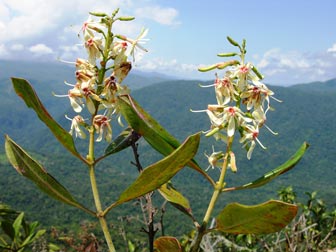
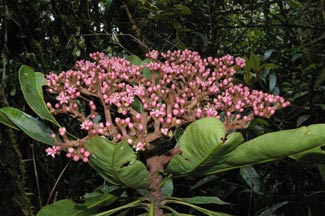
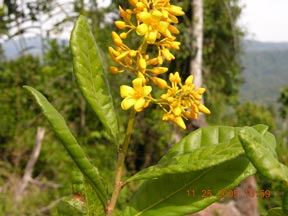
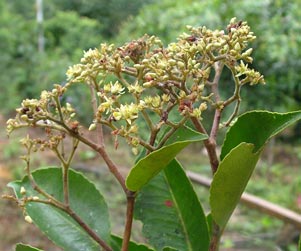
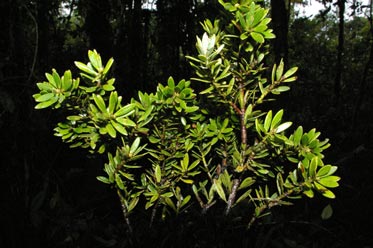
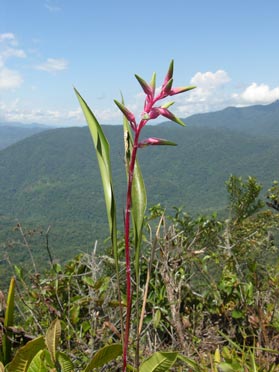
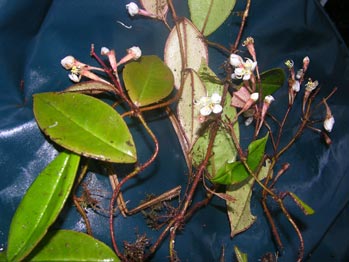
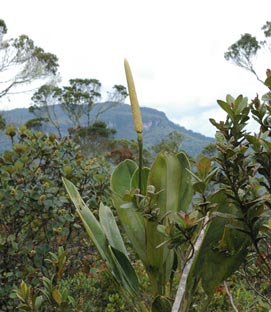
Quantitative Forest Inventories in the Cordillera del Cóndor:
One-hectare Permanent Plots
The summary data for each of the six one-hectare tree plots are presented in the tables on the following pages. The data include the location of each plot, a brief description of the terrain and geologic substrate, the number of individuals, approximate number of species, and total basal area of the trees in each plot. The soils data in these summary charts include just the pH and the soil texture – proportion of sand, silt and clay. The tables list the 15 “most important” species recorded in each plot (in some cases, a genus is listed that includes several different species, not separated in these tables). The maximum diameter attained by each species in the plot is indicated, as well as the sum basal area and number of individuals of each listed species. The “Relative Density” is the proportional number of individuals of each species, with respect to the total number of trees in the plot, on a scale of 0-100, and the “Relative Dominance” is the proportional basal for each species. We use the term “Relative Importance” for the combined values of Relative Density and Relative Dominance for each species, also fitted to a scale of 0-100. Since standing dead trees were so prominent in many of these plots, we include the values for total number of standing dead trees (not identified to family or taxon) in each plot.
Cordillera del Cóndor, Ecuador
Family
Taxon
Max Diam (cm)
Species Basal Area
Species Abundance
Relative Density
Relative Dominance
Relative Importance
ARECACEAE
Wettinia maynensis
19.9
1.63
128
16.5
4.4
10.4
MYRISTICACEAE
Otoba glycycarpa
107.8
3.98
47
6.1
10.7
8.4
BURSERACEAE
Dacryodes peruviana
68.7
2.31
44
5.7
6.2
5.9
RUBIACEAE
Chimarrhis glabriflora
75.5
1.92
11
1.4
5.2
3.3
LECYTHIDACEAE
Grias neuberthii
28.4
0.59
28
3.6
1.6
2.6
MORACEAE
Ficus sp.
150.0
1.77
1
0.1
4.7
2.4
(Various families)
(Standing dead trees)
61.0
1.12
12
1.5
3.0
2.3
MYRISTICACEAE
Virola peruviana
67.3
1.16
9
1.2
3.1
2.1
EUPHORBIACEAE
Mabea standleyi
51.3
0.53
14
1.8
1.4
1.6
MORACEAE
Brosimum utile
113.5
1.01
1
0.1
2.7
1.4
ARECACEAE
Socratea exorrhiza
35.0
0.29
15
1.9
0.8
1.4
MORACEAE
Poulsenia armata
45.0
0.48
9
1.2
1.3
1.2
SAPOTACEAE
Pouteria durlandii
69.8
0.72
4
0.5
1.9
1.2
BURSERACEAE
Protium fimbriatum
39.0
0.39
10
1.3
1.0
1.2
MORACEAE
Perebea xanthochyma
42.0
0.49
6
0.8
1.3
1.1
ULMACEAE
Celtis schippii
47.5
0.39
7
0.9
1.1
1.0
Cordillera del Cóndor, Ecuador
Family
Taxon
Max Diam (cm)
Species Basal Area
Species Abundance
Relative Density
Relative Dominance
Relative Importance
SAPOTACEAE
Chrysophyllum sanguineolentum
41.5
2.18
85
11.0
16.2
13.6
ARALIACEAE
Schefflera harmsii
28.3
1.58
116
15.0
11.7
13.4
ARECACEAE
Socratea exorrhiza
16.0
1.05
101
13.0
7.8
10.4
BURSERACEAE
Dacryodes "condorensis" sp. nov.
25.8
1.26
72
9.3
9.4
9.3
(Various families)
(Standing dead trees)
29.5
0.68
35
4.5
5.0
4.8
ARECACEAE
Euterpe precatoria
18.7
0.45
42
5.4
3.4
4.4
SAPOTACEAE
Pouteria multiflora
27.3
0.36
10
1.3
2.7
2.0
LINACEAE
Roucheria laxiflora
17.7
0.21
16
2.1
1.6
1.8
MYRISTICACEAE
Osteophloeum platyspermum
26.8
0.23
9
1.2
1.7
1.4
FABACEAE
Macrolobium gracile
24.0
0.18
10
1.3
1.4
1.3
MELASTOMATACEAE
Centronia laurifolia
14.5
0.13
11
1.4
1.0
1.2
THEACEAE
Ternstroemia circumscissilis
25.0
0.16
9
1.2
1.2
1.2
MYRISTICACEAE
Compsoneura "morona-santiagoensis" sp. nov.
22.2
0.15
7
0.9
1.1
1.0
MELASTOMATACEAE
Miconia sp.
16.0
0.09
8
1.0
0.7
0.8
ELAEOCARPACEAE
Sloanea sp. nov.
18.5
0.10
7
0.9
0.8
0.8
MYRTACEAE
Myrcia sp nov.
25.7
0.12
5
0.6
0.9
0.8
Cordillera del Cóndor, Ecuador
Family
Taxon
Max Diam (cm)
Species Basal Area
Species Abundance
Relative Density
Relative Dominance
Relative Importance
SAPOTACEAE
Chrysophyllum sanguineolentum
55.0
5.03
128
16.6
20.7
18.7
LAURACEAE
Nectandra and Ocotea (several species)
39.0
1.89
58
7.5
7.8
7.7
(Various families)
(Standing dead trees)
52.0
1.19
34
4.4
4.9
4.7
APOCYNACEAE
Aspidosperma cf. megalocarpon
39.8
0.98
25
3.2
4.0
3.6
CLUSIACEAE
Tovomita "broadleaf" sp. nov.
56.0
0.88
25
3.2
3.6
3.4
CYATHEACEAE
Cyathea caracasana
20.0
0.45
26
3.4
1.8
2.6
RUBIACEAE
Pagamea dudleyi
21.4
0.46
24
3.1
1.9
2.5
BURSERACEAE
Dacryodes peruviana
53.0
0.72
7
0.9
3.0
1.9
MORACEAE
Pseudolmedia laevigata
28.5
0.41
15
1.9
1.7
1.8
MELASTOMATACEAE
Miconia (several species)
42.5
0.34
15
1.9
1.4
1.7
CLUSIACEAE
Clusia (several species)
31.3
0.40
13
1.7
1.6
1.7
MORACEAE
Perebea xanthochyma
31.2
0.37
12
1.6
1.5
1.5
BURSERACEAE
Dacryodes "condorensis" sp. nov.
32.8
0.40
10
1.3
1.6
1.5
FABACEAE
Macrolobium gracile
33.7
0.35
11
1.4
1.4
1.4
RUBIACEAE
Ladenbergia stenocarpa
28.2
0.22
13
1.7
0.9
1.3
EUPHORBIACEAE
Alchornea grandis
40.5
0.37
8
1.0
1.5
1.3
Cordillera del Cóndor, Ecuador
Family
Taxon
Max Diam (cm)
Species Basal Area
Species Abundance
Relative Density
Relative Dominance
Relative Importance
HUMIRIACEAE
Humiria balsamifera
78.0
4.57
70
26.2
12.3
19.2
MELASTOMATACEAE
Miconia (several species)
38.0
0.94
54
5.4
9.5
7.4
EUPHORBIACEAE
Hieronyma (several species)
22.0
0.68
31
3.9
5.4
4.7
SAPOTACEAE
Chrysophyllum sanguineolentum
32.9
0.80
26
4.6
4.6
4.6
BIGNONIACEAE
Digomphia densicoma
31.0
0.66
25
3.8
4.4
4.1
PODOCARPACEAE
Podocarpus sprucei
55.0
0.90
7
5.2
1.2
3.2
CYRILLACEAE
Purdiaea nutans
31.0
0.34
17
2.0
3.0
2.5
CLUSIACEAE
Clusia (several species)
34.9
0.30
12
1.7
2.1
1.9
LAURACEAE
Nectandra (several species)
24.0
0.24
13
1.4
2.3
1.8
MELASTOMATACEAE
Graffenrieda sp.
22.9
0.20
14
1.1
2.5
1.8
FABACEAE
Macrolobium gracile
26.7
0.20
10
1.1
1.8
1.4
(Various families)
(Standing dead trees)
37.0
0.11
12
0.6
2.1
1.4
PODOCARPACEAE
Podocarpus oleifolius
36.9
0.33
4
1.9
0.7
1.3
MALPIGHIACEAE
Byrsonima sp. nov.
27.4
0.20
8
1.1
1.4
1.3
MAGNOLIACEAE
Talauma sp. nov.
29.0
0.21
7
1.2
1.2
1.2
BONNETIACEAE
Bonnetia paniculata
46.4
0.29
3
1.6
0.5
1.1
Cordillera del Cóndor, Ecuador
Family
Taxon
Max Diam (cm)
Species Basal Area
Species Abundance
Relative Density
Relative Dominance
Relative Importance
EUPHORBIACEAE
Alchornea grandiflora
39.3
1.01
41
7.98
7.71
7.84
(Various families)
(Standing dead trees)
38.6
0.79
19
6.21
3.57
4.89
PODOCARPACEAE
Podocarpus tepuiensis
69.0
0.89
9
7.03
1.69
4.36
HUMIRIACEAE
Humiriastrum mapiriense
34.9
0.61
15
4.82
2.82
3.82
ARECACEAE
Dictyocaryum lamarckianum
19.6
0.34
16
2.72
3.01
2.87
MALPIGHIACEAE
Byrsonima sp. nov.
25.0
0.40
10
3.13
1.88
2.51
ARALIACEAE
Schefflera harmsii
24.0
0.25
13
2.01
2.44
2.23
LINACEAE
Roucheria grandiflora
18.5
0.19
15
1.52
2.82
2.17
CLUSIACEAE
Clusia (several species)
21.1
0.17
12
1.36
2.26
1.81
MELASTOMATACEAE
Miconia (several species)
14.5
0.14
13
1.12
2.44
1.78
CLETHRACEAE
Clethra fimbriata
27.8
0.21
9
1.62
1.69
1.66
CLUSIACEAE
Tovomita weddelliana
12.6
0.15
11
1.22
2.07
1.65
MELASTOMATACEAE
Graffenrieda
16.0
0.14
11
1.09
2.07
1.58
FABACEAE
Dussia sp. nov.
27.9
0.23
7
1.79
1.32
1.55
FABACEAE
Ormosia sp. nov.
28.0
0.16
7
1.30
1.32
1.31
Cordillera del Cóndor, Ecuador
Family
Taxon
Max Diam (cm)
Species Basal Area
Species Abundance
Relative Density
Relative Dominance
Relative Importance
ARECACEAE
Wettinia maynensis
14.4
2.70
114
11.7
7.5
9.6
SAPOTACEAE
Chrysophyllum sanguineolentum
59.5
3.28
45
4.6
9.1
6.9
FABACEAE
Inga (several species)
32.9
3.14
41
4.2
8.7
6.5
MYRISTICACEAE
Osteophloeum platyspermum
70.5
3.58
29
3.0
10.0
6.5
MORACEAE
Pseudolmedia laevigata
49.5
1.65
63
6.5
4.6
5.5
ARECACEAE
Iriartea deltoidea
21.1
1.23
59
6.1
3.4
4.7
ARECACEAE
Euterpe precatoria
21.6
0.95
63
6.5
2.6
4.6
BURSERACEAE
Dacryodes "condorensis" sp. nov.
48.8
1.06
20
2.1
3.0
2.5
(Various families)
(Standing dead trees)
44.2
0.98
22
2.3
2.7
2.5
MORACEAE
Helicostylis tomentosa
40.0
0.73
27
2.8
2.0
2.4
EUPHORBIACEAE
Alchornea (several species)
47.7
0.90
17
1.7
2.5
2.1
MELASTOMATACEAE
Miconia (several species)
36.9
0.53
27
2.8
1.5
2.1
MORACEAE
Perebea xanthochyma
38.1
0.65
22
2.3
1.8
2.0
EUPHORBIACEAE
Hieronyma duquei
42.5
0.89
14
1.4
2.5
2.0
HUMIRIACEAE
Vantanea sp. nov.
75.0
1.00
6
0.6
2.8
1.7
FABACEAE
Tachigali sp. nov.
54.6
0.75
12
1.2
2.1
1.7
This preliminary checklist of the bryophytes of the Cordillera del Cóndor was compiled by Steven Churchill of Missouri Botanical Garden, who is the second Co-Principal Investigator on this project. The checklist is based on collections made by Churchill and his Ecuadorian field assistant, Edison Jaramillo, in October-November 2005, in addition to earlier collections from the Cóndor region by Elsa Toapanta, Carla Cole, and other bryologists, in the bryophyte collection of the National Herbarium of Ecuador (QCNE) in Quito.
Bartramiaceae
Breutelia chrysea (Müll. Hal.) A. Jaeger
Leiomela bartramioides (Hook.) Paris
Philonotis hastata (Duby) Wijk & Margad.
Philonotis longiseta (Michx.) E. Britton
Philonotis uncinata (Schwägr.) Brid.
Meteoridium remotifolium (Müll. Hal.) Manuel
Squamidium leucotrichum (Taylor) Broth.
Squamidium livens (Schwägr.) Broth.
Zelometeorium patulum (Hedw.) Manuel
Trematodon longicollis Michx.
Bryum alpinum Huds. ex With.
Bryum renauldii Roll ex Renauld & Cardot
Syrrhopodon leprieurii Mont.
Syrrhopodon lycopodioides (Sw. ex Brid.) Müll. Hal.
Syrrhopodon prolifer var. prolifer
Syrrhopodon rigidus Hook. & Grev.
Campylopus lamellinervis (Müll. Hal.) Mitt.
Campylopus richardii Brid.
Campylopus weberbaueri Broth.
Dicranella hilariana (Mont.) Mitt.
Holomitrium antennatum Mitt.
Holomitrium arboreum Mitt.
Leucoloma serrulatum Brid.
Fissidens asplenioides Hedw.
Fissidens scariosus Mitt.
Fissidens serratus Müll. Hal.
Funaria calvescens Schwägr.
Ectropothecium leptochaeton (Schwägr.) W.R. Buck
Mittenothamnium reptans (Hedw.) Cardot
Rhacopilopsis trinitensis (Müll. Hal.) E. Britton & Dixon
Vesicularia vesicularis (Schwägr.) Broth.
Hypopterygium tamarisci (Sw.) Brid. ex Müll. Hal.
Leucobryum antillarum Schimp. ex Besch.
Leucobryum giganteum Müll. Hal.
Leucobryum martianum (Hornsch.) Hampe ex Müll. Hal.
Ochrobryum gardneri (Müll. Hal.) Mitt.
Macromitrium …
Meteorium deppei (Hornsch. ex Müll. Hal.) Mitt.
Toloxis imponderosa (Taylor) W.R. Buck
Trachypus bicolor var. viridulus (Mitt.) Zanten
Neckeropsis undulata (Hedw.) Reichardt
Porotrichum filiferum Mitt.
Octoblepharum cocuiense Mitt.
Octoblepharum pulvinatum (Dozy & Molk.) Mitt.
Phyllogonium fulgens (Hedw.) Brid.
Phyllogonium viscosum (P. Beauv.) Mitt.
Callicostella pallida (Hornsch.) Ångstr.
Cyclodictyon albicans (Hedw.) Kuntze
Hypnella diversifolia (Mitt.) A. Jaeger
Lepidopilum affine Müll. Hal.
Lepidopilum erectiusculum (Taylor) Mitt.
Lepidopilum scabrisetum (Schwägr.) Steere
Pilotrichum fendleri Müll. Hal.
Thamniopsis killipii (R.S. Williams) E.B. Bartram
Thamniopsis pendula (Hook.) M. Fleisch.
Thamniopsis undata (Hedw.) W.R. Buck
Pogonatum tortile (Sw.) Brid.
Polytrichadelphus longisetus (Brid.) Mitt.
Polytrichadelphus sp.1 [margins ca. entire, orange/red spot absent]
Polytrichum juniperinum Hedw.
Steereobryon subulirostrum (Schimp. ex Besch.) G.L. Sm.
Barbula indica (Hook.) Spreng. var. indica
Barbula indica var. gregaria (Mitt.) R.H. Zander
Prionodon densus (Sw. ex Hedw.) Müll. Hal.
Prionodon luteovirens (Taylor) Mitt.
Racopilum intermedium Hampe
Racopilum tomentosum (Hedw.) Brid.
Pterobryon densum Hornsch.
Pyrrhobryum spiniforme (Hedw.) Mitt.
Acroporium pungens (Hedw.) Broth.
Sematophyllum cucullatifolium (Hampe) Mitt.
Sematophyllum cf. erythropodium Mitt.
Sematophyllum subsimplex (Hedw.) Mitt.
Taxithelium planum (Brid.) Mitt.
Trichosteleum papillosum (Hornsch.) A. Jaeger
Sphagnum magellanicum Brid.
Pilosium chlorophyllum (Hornsch.) Müll. Hal.
Thuidium tomentosum Schimp.
Thuidium urceolatum Lorentz
Balantiopsaceae
Isotachis multiceps (Lindenb. & Gottsche) Gottsche
Isotachis serrulata (Sw.) Gottsche
Mnioloma crenulatum (Bischl.) R.M. Schust. [Calypogeia]
Lophocolea
Anastrophyllum piligerum (Reinw., Blume & Nees) Steph.
Syzygiella concreta (Gottsche) Spruce
Bryopteris filicina (Sw.) Nees
Omphalanthus filiformis (Sw.) Nees
Bazzania hookeri (Lindenb.) Trevis.
Micropterygium trachyphyllum Reimers
Telaranea nematodes (Austin) M. Howe
Pallavicinia lyellii (Hook.) Gray
Plagiochila spp. [4-5 species]
Trichocolea paraphyllina (Spruce) Steph.
© 1995-2025 Missouri Botanical Garden, All Rights Reserved
4344 Shaw Blvd.
St. Louis, MO 63110
(314) 577-5100
Technical Support